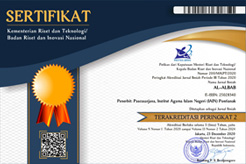The Myth of Religious “Radicalism”
Abstract
Keywords
Full Text:
PDFReferences
Abu-Lughod, L. (2013). Do Muslim Women Need Saving? Massachusetts: Harvard University Press.
Armstrong, Karen. (2005). A Short History of Myth. London: Canongate Books.
------. (2014). The Myth of Religious Violence. The Guardian.com:
www.theguardian.com/world/2014/sep/25/-sp-karen-armstrong-religious-violence-myth-secular. Accessed, August 22, 2019.
Arnswald, U. (2009). In Search of Meaning : Ludwig Wittgenstein on Ethics, Mysticism and Religion. In Search of Meaning : Ludwig Wittgenstein on Ethics, Mysticism and Religion. https://doi.org/10.26530/oapen_422396
Bakardjieva, M. (2005). Internet Society: The Internet in Everyday Life. London: Sage Publication.
Barthes, R. (2007). Myth today. In Stardom and celebrity: A reader. https://doi.org/10.4135/9781446269534.n5
Bonner, M. (2006). Jihad In Islamic History: Doctrines and Practice. New Jersey: Princeton University Press.
Chomsky, N. (1956). Three models for the description of language. IRE Transactions on Information Theory. https://doi.org/10.1109/TIT.1956.1056813
Chomsky, N. (2005). Three factors in language design. Linguistic Inquiry. https://doi.org/10.1162/0024389052993655
Chomsky, N. (2013). Problems of projection. Lingua. https://doi.org/10.1016/j.lingua.2012.12.003
Cook, J. W. (2000). Wittgenstein, empiricism, and language. New York: Oxford University Press. https://doi.org/10.5860/choice.38-1490
Das, V. (1998). Wittgenstein and anthropology. Annual Review of Anthropology, 27, 171–195. https://doi.org/10.1146/annurev.anthro.27.1.171
Fatmawati, F., Noorhayati, S., & Minangsih, K. (2018). Jihad Penista Agama Jihad NKRI: Antonio Gramsci's Hegemony Theory Analysis of Radical Da'wah Phenomena in Online Media. Al-Albab, 7(2), 199-220. doi:https://doi.org/10.24260/alalbab.v7i2.1174
Fitch, W. T., Hauser, M. D., & Chomsky, N. (2005). The evolution of the language faculty: Clarifications and implications. Cognition. https://doi.org/10.1016/j.cognition.2005.02.005
Fontana, B. (2008). Hegemony and power in Gramsci. In Hegemony: Studies in Consensus and Coercion (pp. 80–106). https://doi.org/10.4324/9780203927182
Kale, S. H. (2004). Spirituality, Religion, and Globalization. Journal of Macromarketing. https://doi.org/10.1177/0276146704269296
Khalil, M. H. (2018). Jihad , Radicalism , and the New Atheism. United Kingdom: Cambridge University Press.
Levi-Strauss, C. (1955). The Structural Study of Myth. The Journal of American Folklore. https://doi.org/10.2307/536768
Levi-Strauss, C. (1979). Myth and Meaning. RAIN. https://doi.org/10.2307/3032441
Lewis, S. E. (2008). Ayahuasca and Spiritual Crisis: Liminality as Space for Personal Growth. Anthropology of Consciousness. https://doi.org/10.1111/j.1556-3537.2008.00006.x
Luke, T. W. (1991). Power and politics in hyperreality: The critical project of Jean Baudrillard. The Social Science Journal. https://doi.org/10.1016/0362-3319(91)90018-Y
Mahmood, S. (2005). Politics of Piety: The Islamic Revival and the Feminist Subject. New Jersey: Princeton University Press.
Mark, P. (2002). Everyday ( Virtual ) Life. JSTOR, 33(4), 743–760.
Martel, J. R. (2012). Divine Violence. New York: Routledge.
McLaughlin, P. (2012). Radicalism: A Philosophical Study. New York: Palgrave Macmillan.
Meyer, B., & Moors, A. (2006). Religion , MEDIA , and the Public Sphere. Bloomington: Indiana University Press.
Millard, M. (2004). Jihad in Paradise: Islam and Politics in Southeast Asia. New York: An East Gate Book.
Nasto, B. (1996). The power of myth. Nature Medicine. https://doi.org/10.1038/nm1096-1062b
Nunes, M. (2016). Jean Baudrillard in Cyberspace : Internet , Virtuality , and Postmodernity. Jstor.
Nurish, A. (2019). Ilusi , Kecemasan , Dan Tindakan Kekerasan From Fanaticism To Extremism : Illusions , Anxiety , and Acts of Violence. LIPI : Jurnal Masyarakat Dan Budaya. https://doi.org/http://dx.doi.org/10.14203/jmb.v21i1.829
Perry, N. (2012). Hyperreality and global culture. Hyperreality and Global Culture. https://doi.org/10.4324/9780203019375
Rahmatullah, Y. (2017). Radicalism, Jihad and Terror. Al-Albab, 6(2), 157 - 178. doi:https://doi.org/10.24260/alalbab.v6i2.731
Robinson, A. (2012). Jean Baudrillard: Hyperreality and Implosion. Ceasefire Magazine.
Sewell, W. H. (1992). A Theory of Structure: Duality, Agency, and Transformation. American Journal of Sociology, 98(1), 1–29. https://doi.org/10.1086/229967
Siddiq, A. (2019). Academic Approach for Religious Radicalism. Al-Albab, 8(2), 163 - 178. doi:https://doi.org/10.24260/alalbab.v8i2.1276
Solahudin. (2013). The Roots of Terrorism in Indonesia. Sydney: UNSW Press Book.
Stolze, T., & Stolze, T. (2019). Contradictions of Hyperreality: Baudrillard, Žižek, and Virtual Dialectics. In Becoming Marxist. https://doi.org/10.1163/9789004280984_012
Tweeten, L. (2003). Terrorism, radicalism, And Populism In Agriculture. Lowa: Lowa State Press.
Vincent B. Leitch. (2004). Postmodern Theory of Technology : Agendas. JSTOR, 12(1), 209–215.
Ziegler, H., & Findley, T. (1997). Myth and Metaphor. In Rewriting History. https://doi.org/10.1007/978-3-476-04274-3_3
Article Metrics
 Abstract views: 4196
Abstract views: 4196
 PDF views: 1594
PDF views: 1594











